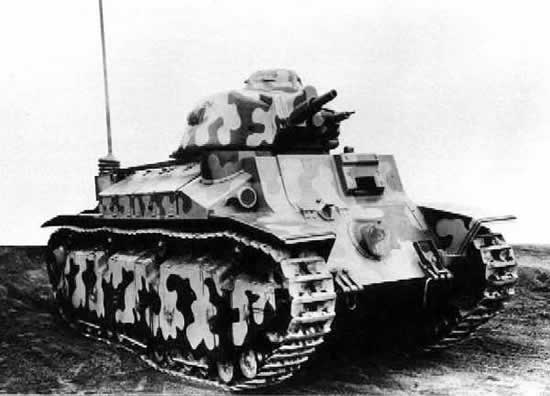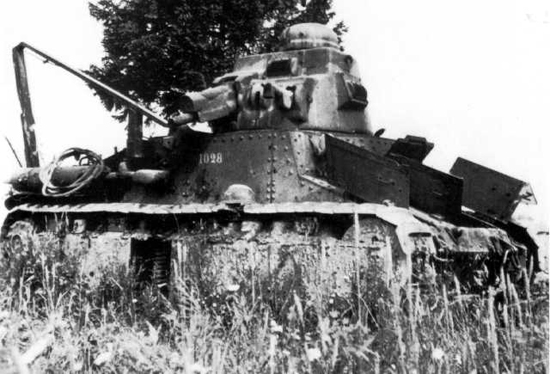|
Renault D1 and Renault D2DescriptionThe Char D1 was a medium tank that by 1937 was obsolete and all vehicles where shipped to equip the French troops in North Africa where they were meant to counter Italy's ambitions in Tunisia. After the invasion of France, they were rushed back home in time to take part in the fighting in June. The Char D2 medium tank was a better armed and more reliable successor; it saw action in France in 1940 and gained renown as part of De Gaulle's Armoured Division (4e DCR).
DevelopmentThe development plan of 1926 called for a cheap mass-produced light tank to replace the Renault FT-17. Renault developed the Char D to fulfil these requirements, but it was neither cheap nor particularly light. The Char D was classed as a Char d'Bataille: a main battle tank. Although not a light tank, it was considerably cheaper than the Char B1 so it's development continued. The development plan for a light tank then continued side by side with that of the D1 and resulted in three production tanks: Hotchkiss H 35, Renault R 35 and the FCM 36. In 1928 Renault built two prototypes, called NC28 by Renault and Char D by the Army. In December 1929 an order was placed for a pre-series of ten vehicles, called the Renault NC31, after the intended year of delivery. The ten pre-series hulls were delivered between May and November and were tested by the 503e Régiment de Chars de Combat (RCC). These 10 vehicles were followed on 23 December 1930 by the first order of 70 production series vehicles. On 12 July 1932 by a second order of 30 was placed, with a final order for 50 more on 16 October 1933. The last of these 160 vehicles was delivered in early 1935. Because of problems with the planned turret, all vehicles were initially fitted with 37mm SA18 gun turrets from the FT-17. In 1936 these were replaced by the new ST2 turreet equipped with the 47mm SA34 gun. No D1 vehicles exist today, except one very early Renault NC prototype, often referred to as the NC27. It was sold to Sweden where it was known as the stridsvagn fm/28 and used mainly for driver training without its 37mm gun turret. It can be found at the Panser Museum in Axvall. As early as May 1930, even though the Char D was not yet in series production, Renault was asked to develop an improved model and a colonial version. Despite having its armour increased to 40mm, it was required to have an increased speed. The improved model was named Char D2, the colonial version the Char D3 and the original became the Char D1. The Char D3 never entered production. The first rivited prototype of the D2 was delivered in April 1932 and field trials were again carried out by the 503e RCC. This was followed by two welded prototypes in November 1933. These were also used to compare petrol with diesel engines. The Char D2 was accepted for production in December of the following year and on 14 January 1934 an initial order for 50 production vehicles was placed, these being delivered between May 1936 and February 1937. A second order was placed for another 50 vehilces in which were delivered just in time to see combat. The production vehicles used petrol engines and welded construction although with fewer welded sections to reduce price. The first 50 production vehicles had the same APX-1 turret as the Char B1, this like the D1, had the short 47 SA34 gun. The second production run replaced this with the long 47 SA35 gun.
OperationThe Char D1 & D2 both had three crew members; commande, driver and radio-operator. The commander was very overworked in the one-man turret. Apart from directing the driver, who had a very limited vision, the commander was also the main gunner and loader. So in action he would have his head in the cupola directing the driver, he would then have to spot the target and jump down into the turret when he would load with the correct ammunition, rotate the turret onto the target, peer through the gun-sight and set the range, finally fire the gun. He could also operate the coaxial machine-gun. The turret had a cupola where most tanks of other nations would have a turret hatch. The commander could not raise his head out of the turret and thus had a more restricted view than was possible for German tank commanders who often when into battle so. When not in combat, the D2 commander often rode sitting on the hatch at the rear of the turret. The driver and radio-operator were in the hull, the driver sat on the left and the radio-operator beside him to the right. The driver also operated the hull machine-gun.The radio-operator operated the morse-code wireless set on the right side of the fighting compartment. RadioThe D1 and D2 tanks had the ER 52 wireless set for the internal company network. It had a range of 2km and was morse key operated. The D1 had a large triangular antenna-frame on the right of the rear deck. The D2 had an ariel positioned at the back right corner of the rear deck. Char D2 command vehicles had a second ER 52 bis wireless set for the tank battalion command net. This had a range of 3 km and was morse key operated. These command tanks could be recognised by a second aerial on the left rear of the vehicle's deck. DeploymentThe Char D tanks were intended to be deployed to independant tank battalions (BCC). Because they were obsolete, the D1 tanks were assigned to battalions in North Africa. Most of the D2 tanks were assigned to the newly forming 4e DCR. 10th May 1940Char D1On May 10th there were 135 Char D1 tanks with combat units, all in Tunisia. Additionally there were 8 tanks in training schools in France and 17 replacement tanks in Tunisia. The 67th BCC was shipped back to France and arrived in early June.
Char D2On May 10th there were 45 Char D2 tanks with combat units in France. Of these, 31 had the short SA34 gun and 14 the long SA35 gun
During the rest of the month the following new D2 combat units were formed. All had the long SA35 gun.
Technical Data
| ||||||||||||||||||||||||||||||||||||||||||||||||||||||||||||||||||||||||||||||||||||||||||||||||||||||||||||||||||||



